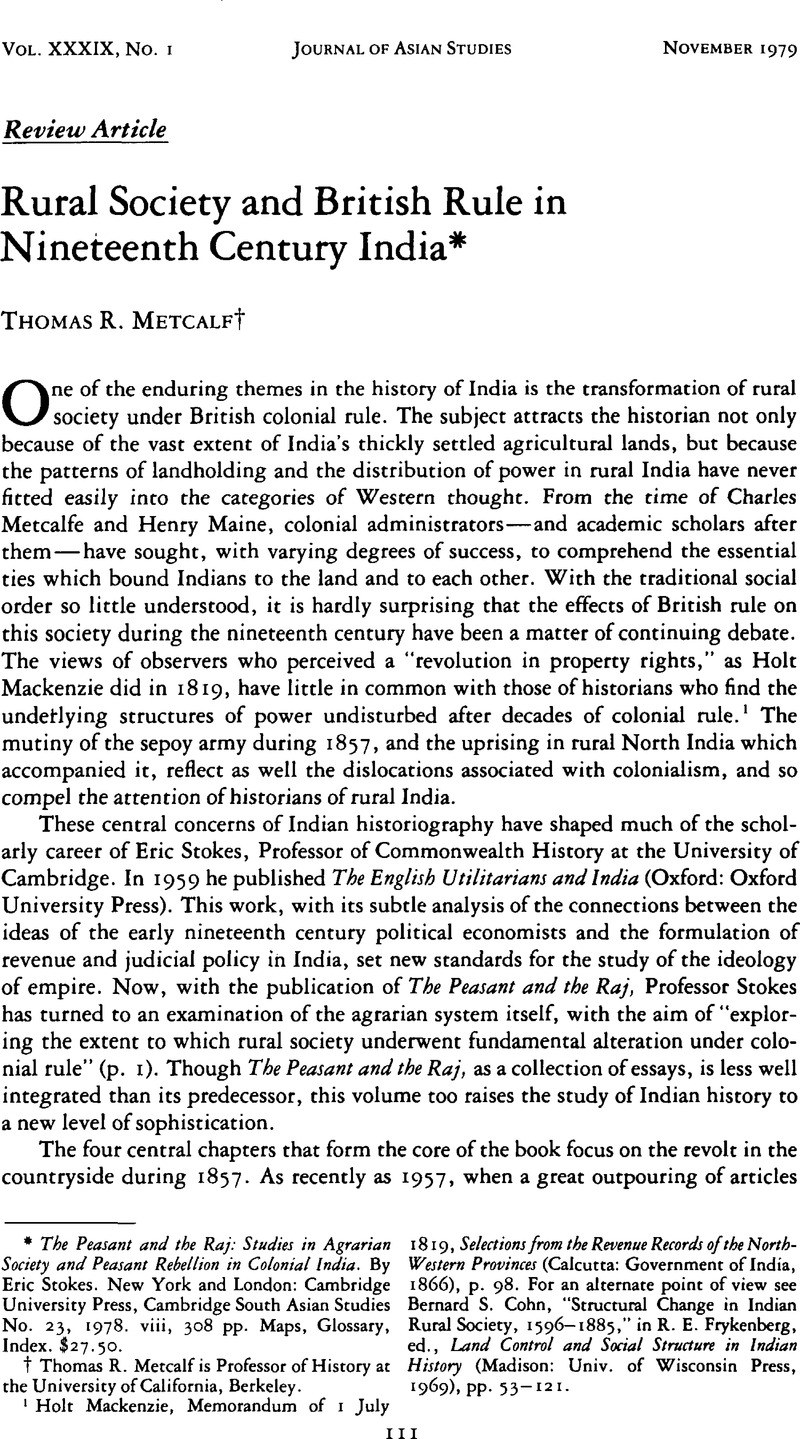Article contents
Rural Society and British Rule in Nineteenth Century India*
Published online by Cambridge University Press: 23 March 2011
Abstract

- Type
- Review Article
- Information
- Copyright
- Copyright © The Association for Asian Studies, Inc. 1979
References
1 Mackenzie, Holt, Memorandum of 1 July 1819 Selections from the Revenue Records of the North-Western Provinces (Calcutta: Government of India, 1866), p. 98Google Scholar. For an alternate point of view see Cohn, Bernard S., “Structural Change in Indian Rural Society, 1596–1885,” in Frykenberg, R. E., ed., Land Control and Social Structure in Indian History (Madison: Univ. of Wisconsin Press, 1969), pp. 53–121Google Scholar.
2 Chaudhuri, S. C., Theories of the Indian Mutiny (Calcutta: The World Press, 1965), pp. 135–36Google Scholar.
3 Metcaif, Thomas R., The Aftermath of Revolt: India, 1857–1870 (Princeton: Princeton Univ. Press, 1964), p. 62 et passimGoogle Scholar.
4 For further discussion of these men, and a general account of the revolt in the North-western Provinces, see my Land, Landlords and the British Raj (Berkeley: Univ. of California Press, 1979), ch. 6Google Scholar. Gobind Singh was apparently moved to remain loyal by his clan ties to the other loyal Jat landholders of Aligarh.
5 For a perceptive discussion of this question, see Brodkin, E. I., “The Struggle for Succession: Rebels and Loyalists in the Indian Mutiny,” Modern Asian Studies 6 (1972): 277–90CrossRefGoogle Scholar. Once labeled a “rebel,” a landholder often had no alternative but to act as one, for the British would not treat him otherwise. The belated rebellion of the Rani of Jhansi is perhaps the most famous such incident.
6 For the eighteenth century risings, see Srivastava, A. L., The First Two Nawabs of Oudh (Agra: Shiva Lai Agarwala, 1954), pp. 35–43, 93–95, 166Google Scholar; idem, Shuja-ud-daula (Agra: Shiva Lai Agarwala, 1961), 1: 235–36, 247–51Google Scholar. In the later phase of the revolt, especially after the issuance of the Oudh Proclamation in March 1858, which ordered the confiscation of all land in the province, the taluqdars' resistance may well have been stiffened by a fear and dislike of the British.
7 See Musgrave, P. J., “Landlords and Lords of the Land: Estate Management and Social Control in Uttar Pradesh, 1860–1920,” Modern Asian Studies 6 (1972): 257–72CrossRefGoogle Scholar; and my Land, Landlords and the British Raj, ch. 9. For a recent account arguing the traditional point of view, see Siddiqi, M. H., Agrarian Unrest in North India: The United Provinces 1918–1922 (New Delhi: Vikas, 1978)Google Scholar, especially ch. 2. As the occupancy tenants in Oudh who were the subjects of Siddiqi's research had less protection than those in Agra, they may have been less well-off. Only detailed study of estate and district records can answer this question.
8 Stokes's “Peasants, Moneylenders, and Colonial Rule in Central India,” the only previously unpublished essay in the book, contains a stimulating account of the short-lived “boom” in the Central Provinces (see especially pp. 258–63). See also Harnetty, Peter, “Crop Trends in the Central Provinces of India, 1861–192 1,” Modern Asian Studies 11 (1977): 341–78CrossRefGoogle Scholar. For early nineteenth century developments in the Gangetic valley, see Siddiqi, Asiya, Agrarian Change in a Northern Indian State: Uttar Pradesh 1819–1833 (Oxford: Oxford Univ. Press, 1973), ch. 5Google Scholar; Bayly, C. A., “Town Building in North India, 1790–1830,” Modern Asian Studies 9 (1975): 483–96CrossRefGoogle Scholar; and Bayly's unpublished paper, “Inland Port Cities in North India: Calcutta and the Gangetic Plain, 1780–1900,” presented to the conference on Colonial Port Cities in Asia at Santa Cruz, California, and summarized in Basu, Dilip K., ed., The Rise and Growth of Colonial Port Cities in Asia (Santa Cruz: Center for South Pacific Studies, Univ. of California, Santa: Cruz, 1979)Google Scholar.
9 For preliminary accounts at the local level, see Ludden, David, “Agrarian Organization in Tinne-velly District” (Ph.D. diss., University of Pennsylvania, 1978), especially ch. 8Google Scholar; and Kessinger, T. G., Vilyatpur 1848–1968 (Berkeley: Univ. of California Press, 1974)Google Scholar, especially ch. 4. Punjab farmers also showed a readiness to accept agricultural innovation; see Pray, Carl, “The Economics of Agricultural Research in British Punjab and Pakistani Punjab, 1905–1975” (Ph.D. diss., University of Pennsylvania, 1978)Google Scholar.
10 See, for example, Bundy, Colin, The Rise and Fall of the South African Peasantry (London: Heinemann, 1979)Google Scholar. Stokes cites the work of J. M. Lonsdale and J. Iliffe on the African peasantry, but only in connection with the growth of resistance movements (pp. 121, 125).
11 Rajat and Ratna Ray, “The Dynamics of Continuity in Rural Bengal Under The British Imperium,” Indian Economic and Social History Review 10 (1973): 103–28Google Scholar; Ray, Rajat, “The Crisis of Bengal Agriculture, 1870–1927—the Dynamics of Immobility,” Indian Economic and Social History Review 10(1973): 244–79CrossRefGoogle Scholar.
12 For brief accounts of this lifestyle, see Raychaudhuri, Tapan, “Permanent Settlement in Operation: Bakarganj District, East Bengal,” in Frykenberg, Robert Eric, ed., Land Control and Social Structure in Indian History (Madison: Univ. of Wisconsin Press, 1969), pp. 163–74Google Scholar; and my Land, Landlords and the British Raj, ch. 12.
13 For the zamindar, see Islam, M. M., Bengal Agriculture 1920–1946, a Quantitative Study (Cambridge: Cambridge Univ. Press, 1978), ch. 7Google Scholar. For the peasants' economic behavior, see the papers presented at the S.S.R.C.–sponsored Workshop on the Effects of Risk and Uncertainty on Economic and Social Processes in South Asia, at the University of Pennsylvania, 1977.
14 Musgrave, P. J., “Rural Credit and Rural Society in the United Provinces,” in Dewey, Clive and Hopkins, A. G., eds., The Imperial Impact: Studies in the Economic History of Africa and India (London: Athlone Press, 1978), pp. 216–32Google Scholar.
- 2
- Cited by


